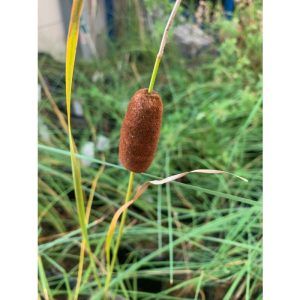Cattail (Cigar plant) - Water Purifying Pond Plant
Home " Bank plants " Cattail
Lizzard. The Famous Cigar Plant.
During the flowering season, from June to September, they can be seen from afar; the cobs of the Cattail. The cigar-like inflorescence turns from green to brown during the season. Formerly, the cobs were used to clean the inside of narrow objects.
Besides the nice view, the Cattail is great for removing nutrients such as phosphate and nitrogen from the water. It thus improves water quality. Cattail can also temporarily store a lot of excess water during a heavy rainfall, for example.
Contrary to what its name suggests, the Lesser Cattail does not differ much in length from the Greater Cattail. It is the leaves of the 'small' variety that are narrower.
Properties of the Cattail (Cigar plant)
- Latin name: Typha angustifolia
- Position: Sun/semi-shade
- Planting depth: 10-50 cm
- Stem length: 80 to 300 cm
- Substrate: Necessary, rooting aquatic plant
Frequently asked questions
Is bulrush a protected plant?
Cattail (Typha) is not a protected plant in the Netherlands and Belgium, although some specific species may possibly be locally protected due to their scarcity. However, it is important to consider the environment in which you find the plant. Cattail plays a crucial role in wet ecosystems and is often found in natural wetlands and along water sides. Before removing rhizomes from the wild, check local regulations and conservation guidelines.
How tall does cattail grow?
Cattail can reach impressive heights, ranging from 1 to as much as 3 metres, depending on the species and growing conditions. The broad cattail (Typha latifolia) is often the largest species, while the narrow cattail (Typha angustifolia) stays slightly lower. It has sturdy, upright stems with characteristic, cigar-shaped flowers that rise far above the surrounding vegetation.
What is the planting depth of cattail?
Bulrush grows best in shallow water or moist soil, with an ideal planting depth of 10 and 50 cm under water. The rhizomes should be firmly anchored in the mud. In deeper water, the plant will struggle to grow properly, as the leaves and stems do not get adequate support. Place bulrush along pond edges or in marsh zones for optimal growth.
How should I prune bulrush?
Cattail needs little pruning, but you can remove dead or damaged leaves in early spring to make the plant look neater and encourage new growth. The plant can proliferate, so if it takes up too much space, you can cut off the stems or thin out the rhizomes in autumn. Make sure you use gloves while pruning as the leaves can be sharp.
What are tips for planting cattail?
Typha angustifolia, or Little Lichodder, takes root in the soil. Due to its high growth rate, it can quickly proliferate. It is therefore wise to place the plant in a pond basket. The Cattail is ideal for edging pond edges or hard bank protection.
How do I maintain cattail?
Cattail is a low-maintenance plant. The most important thing is to make sure the plant is constantly in moist soil or shallow water. Remove dead leaves and stems in early spring to encourage new growth. If the plant gets too big, you can divide it in autumn or early spring by digging up the rhizomes and splitting them. Also, keep an eye out for excessive spreading, as cattail quickly proliferates and can crowd out other plants.
Buy Cattail?

Cattail is for sale via De Vijvermeester's webshop. Here you can find beautiful, high-quality plants.
